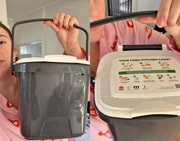It looks like Wise, talks like Wise…but it will drain your savings in minutes
By
Maan
- Replies 0
You thought you'd finally found the perfect savings account—steady interest, a trusted name, and just a little better than the rest.
But the moment you clicked, you were already caught in one of the slickest scams running in the UK right now.
These aren't just phishing emails or dodgy texts—this is a full-scale con complete with logos, fake accounts, and cloned communication.
It all started with an ad offering an attractive rate: 5.55 per cent on a one-year easy-access savings account, or 5.85 per cent for locking in your cash for 12 months.
On the surface, the offer looked completely legit—using the well-known brand Wise, complete with the correct postal address and convincing visuals.
Once someone clicked, they were prompted to fill in a form and wait for a call to discuss the investment.
What made it especially believable was that the rates were only slightly better than average, adding just enough plausibility without triggering suspicion.
The scammer, fluent in English and armed with detailed scripts, would then guide the victim through setting up a real Wise account under the guise that it was for saving, not realising it was the scammers who would ultimately control it.
Martin Richardson from the National Fraud Helpline called it ‘one of the most sophisticated and convincing scams we have seen’.
He explained: ‘Once they have your details, they will instantly recognise your phone number and ask you to pass security questions. The email address seems very believable, but it’s the English-speaking scammers that add a high level of plausibility.
‘We think that when the scammers help set up the victim’s genuine Wise account, they put the two-factor authentication and virtual card details into their own phone.’
With this, they could load the victim’s new Wise account onto Apple Pay and siphon off all funds into accounts under their control.
Even more alarming, the fake savings ads were promoted through paid social media ads, giving them a layer of perceived legitimacy.
Wise confirmed it had seen these impersonation attempts and acted quickly to remove fake content when detected.
‘We’re aware of scams that use branding of financial services providers to deceive people into thinking they are holding, or investing, their money.
‘Whenever we come across fraudulent attempts to impersonate Wise, including on social media platforms, we take prompt action to get the content removed.’
This type of fraud falls under authorised push payment (APP) scams—where victims are tricked into willingly transferring their own money.
Thanks to rules introduced last year, people who sent money to another UK account should be eligible to claim reimbursement from their bank or payment provider.
Victims are advised to immediately contact Wise via its website instructions, file a police report, and notify the Financial Conduct Authority.
Richardson added that his firm had helped two victims recover more than £20,000 each after falling prey to this particular scam.
Scams that look professional and play on trust are becoming harder to spot—especially when they mimic real financial institutions.
But savings aren’t the only target, and con artists are now turning their attention to something even bigger: superannuation.
If you're curious how these scams work and what warning signs to watch for, here’s another story worth your time.
Read more: Finance experts warn Aussies about rising superannuation scams. Are you their next target?

When even the logos and email addresses look real, how can anyone be sure their money is safe?
But the moment you clicked, you were already caught in one of the slickest scams running in the UK right now.
These aren't just phishing emails or dodgy texts—this is a full-scale con complete with logos, fake accounts, and cloned communication.
It all started with an ad offering an attractive rate: 5.55 per cent on a one-year easy-access savings account, or 5.85 per cent for locking in your cash for 12 months.
On the surface, the offer looked completely legit—using the well-known brand Wise, complete with the correct postal address and convincing visuals.
Once someone clicked, they were prompted to fill in a form and wait for a call to discuss the investment.
What made it especially believable was that the rates were only slightly better than average, adding just enough plausibility without triggering suspicion.
The scammer, fluent in English and armed with detailed scripts, would then guide the victim through setting up a real Wise account under the guise that it was for saving, not realising it was the scammers who would ultimately control it.
Martin Richardson from the National Fraud Helpline called it ‘one of the most sophisticated and convincing scams we have seen’.
He explained: ‘Once they have your details, they will instantly recognise your phone number and ask you to pass security questions. The email address seems very believable, but it’s the English-speaking scammers that add a high level of plausibility.
‘We think that when the scammers help set up the victim’s genuine Wise account, they put the two-factor authentication and virtual card details into their own phone.’
With this, they could load the victim’s new Wise account onto Apple Pay and siphon off all funds into accounts under their control.
Even more alarming, the fake savings ads were promoted through paid social media ads, giving them a layer of perceived legitimacy.
Wise confirmed it had seen these impersonation attempts and acted quickly to remove fake content when detected.
‘We’re aware of scams that use branding of financial services providers to deceive people into thinking they are holding, or investing, their money.
‘Whenever we come across fraudulent attempts to impersonate Wise, including on social media platforms, we take prompt action to get the content removed.’
This type of fraud falls under authorised push payment (APP) scams—where victims are tricked into willingly transferring their own money.
Thanks to rules introduced last year, people who sent money to another UK account should be eligible to claim reimbursement from their bank or payment provider.
Victims are advised to immediately contact Wise via its website instructions, file a police report, and notify the Financial Conduct Authority.
Richardson added that his firm had helped two victims recover more than £20,000 each after falling prey to this particular scam.
Scams that look professional and play on trust are becoming harder to spot—especially when they mimic real financial institutions.
But savings aren’t the only target, and con artists are now turning their attention to something even bigger: superannuation.
If you're curious how these scams work and what warning signs to watch for, here’s another story worth your time.
Read more: Finance experts warn Aussies about rising superannuation scams. Are you their next target?
Key Takeaways
- Scammers used fake social media ads to impersonate the money transfer service Wise.
- Victims were tricked into opening real Wise accounts, unknowingly giving scammers control.
- The scam offered fake savings products with slightly higher interest to maintain plausibility.
- New rules may help victims reclaim funds, provided the money stayed within UK accounts.
When even the logos and email addresses look real, how can anyone be sure their money is safe?








